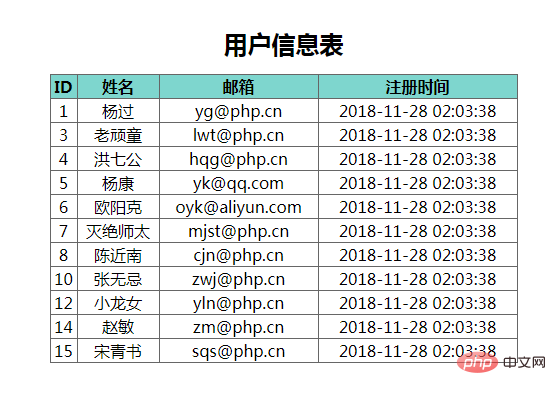abstract:一.PDO 查询操作 + 1.连接数据库,创建PDO对象 - $pdo = new PDO($dsn,$user,$pass); + 2.执行预处理方法,创建预处理对象 &nb
一.PDO 查询操作
+ 1.连接数据库,创建PDO对象
- $pdo = new PDO($dsn,$user,$pass);
+ 2.执行预处理方法,创建预处理对象
- $stmt = $pdo->prepare($sql);
+ 3.执行查询
- $stmt->execute();
+ 4.解析结果集
- $stmt->fetchAll(); 可预测不是特别多的数据用这个
+ 5.遍历结果集:通常用foreach()结构
//1.创建PDO对象 连接数据库
$pdo = new PDO('mysql:host=127.0.0.1;dbname=php_edu;charset=utf8','root','root');
//2.创建预处理对象STMT
$sql = "SELECT `user_id`,`name`,`email`,`create_time` FROM `user` WHERE `status`= :status";
$stmt = $pdo->prepare($sql); //创建预处理对象 并使用占位符:status进行参数绑定
//提前设置解析结果集的模式
$stmt->setFetchMode(PDO::FETCH_ASSOC); //设置解析结果集的模式 只解析关联部分
//$stmt->setFetchMode(PDO::FETCH_NUM); //设置解析结果集的模式 只解析索引部分
//$stmt->setFetchMode(PDO::FETCH_BOTH); //设置解析结果集的模式 默认全部解析
//3.执行SQL语句
if($stmt->execute([':user_id'=>2])){ //将绑定参数以数组的形式传到execute中 成功则解析结果集
//4.解析结果集
$rows = $stmt->fetchAll(); //
}else{
print_r($stmt->errorInfo());die();
}
//5.遍历结果集
foreach ($rows as $row) {
echo print_r($row,true).'<hr>';
}
//获取表中所有的记录数量
$stmt = $pdo->prepare("SELECT count('*') AS `num` FROM `user`");
$stmt->execute();
echo '表中共有'.$num.'条记录'.'<br>';二.PDO查询操作之fetch() 和while() 进行结果集遍历
+ 操作步骤与之前的查询案例是相同的;
+ 参数绑定:bindParam()和bindValue()
+ fetch()与while()解析遍历结果集
+ Mysql对游标查询支持不够完善,如果想在结果集中巡航,请把结果集解析到数组中进行
//1.创建PDO对象 连接数据库
$pdo = new PDO('mysql:host=127.0.0.1;dbname=php_edu;charset=utf8','root','root');
//2.创建预处理对象STMT
$sql = "SELECT `user_id`,`name`,`email`,`create_time` FROM `user` WHERE `status`= :status";
$stmt = $pdo->prepare($sql);
//3.操作sql语句
$stmt->execute([':status'=>1]);
//4.遍历结果
$rows = []; //创建一个空数组
while($row = $stmt->fetch(PDO::FETCH_ASSOC)){ //解析关联信息
$rows[] = $row; //将每一次的遍历数组传入到$rows空数组中
}
//5.释放结果集
$stmt = null;
//6.关闭连接
$pdo = null;
//print_r($rows);
?>
<style>
table,th,td{
border:1px solid #666;
}
table {
text-align: center;
border:1px solid #333;
width: 50%;
margin: 50px auto;
border-collapse: collapse;
}
table caption{
font-size: 1.5em;
font-weight: bolder;
margin-bottom: 15px;
}
table tr:first-child{
background: #7ed6ce;
}
</style>
<table>
<caption>用户信息表</caption>
<tr>
<th>ID</th>
<th>姓名</th>
<th>邮箱</th>
<th>注册时间</th>
</tr>
<?php foreach($rows as $row) : ?>
<!-- --><?php //foreach($rows as $row) { ?>
<tr>
<td><?php echo $row['user_id']; ?></td>
<td><?php echo $row['name']; ?></td>
<td><?php echo $row['email']; ?></td>
<td><?php echo date('Y-m-d H:i:s',$row['create_time']); ?></td>
</tr>
<?php endforeach; ?>
<!-- --><?php // }?>
</table>fetch()有些像each() 进行一次查询将指针下移一次 和while很相配
foreach 的替代语法 就是将左边大括号换成 " : " 右边大括号换成"endforeach;"
if,while,for,foreach 和 switch 也同理

三.PDO查询操作之参数绑定 bindParam(),bindValue() 列绑定 bindColumn()
+ 再次强调PDO查询中的二个绑定操作:参数绑定与列绑定
+ 参数绑定
* bindParam(':占位符',变量,类型常量),类型常量默认为字符串;
* bindValue(':占位符',值活变量,类型常量),如果直接传值,可省略类型常量;
* execute([':占位符'=>值/变量]) :将参数以数组的方式与SQL语句的占位符绑定
+ 列绑定
* bindColumn('列名或索引',变量,变量类型,最大长度),如果是字符串类型,应该指出最大长度进行预分配
将之前的execute中的参数拿出 用bindParam()/bindValue()进行绑定 他俩的区别就是bindParam只支持传入变量
//1.创建PDO对象 连接数据库
$pdo = new PDO('mysql:host=127.0.0.1;dbname=php_edu;charset=utf8','root','root');
//2.创建预处理对象STMT
$sql = "SELECT `user_id`,`name`,`email`,`create_time` FROM `user` WHERE `status`= :status";
$stmt = $pdo->prepare($sql);
//3.1参数绑定
//$status = 1;
//$stmt->bindParam(':status',$status,PDO::PARAM_INT); //第三个参数是 传入绑定的值的类型 PDO::PARAM_INT 整数
$stmt->bindValue(':status',1,PDO::PARAM_INT); //可以直接传入字面量
$stmt->execute(); //执行sql
//4.遍历结果
//将每一列的数据进行列绑定
$stmt->bindColumn(1,$id,PDO::PARAM_INT); //第一列绑定到变量$id中 第三个参数为绑定数据额类型 PDO::PARAM_INT整数
$stmt->bindColumn(2,$name,PDO::PARAM_STR,20); //第二列绑定到变量$name中 PDO::PARAM_STR字符串类型 并设置第四个参数 限制长度
$stmt->bindColumn(3,$email,PDO::PARAM_STR,50); //第三列绑定到变量$email中 PDO::PARAM_STR字符串类型 并设置第四个参数 限制长度
$stmt->bindColumn(4,$createTime,PDO::PARAM_INT); //第四列绑定到变量$createTime中 PDO::PARAM_INT整数类型
while($stmt->fetch(PDO::FETCH_BOUND)){ //解析模式换成绑定模式 PDO::FETCH_BOUND
// echo $id,$name,$email,$createTime.'<br>'; 遍历出一行中所有的数据
//将变量转为关联数组
$rows[] = compact('id','name','email','createTime'); //compact 将字符串转换为关联数组 是传入变量名的字符串 不是变量
}
//5.释放结果集
$stmt = null;
//6.关闭连接
$pdo = null;
?>
<style>
table,th,td{
border:1px solid #666;
}
table {
text-align: center;
border:1px solid #333;
width: 50%;
margin: 50px auto;
border-collapse: collapse;
}
table caption{
font-size: 1.5em;
font-weight: bolder;
margin-bottom: 15px;
}
table tr:first-child{
background: #7ed6ce;
}
</style>
<table>
<caption>用户信息表</caption>
<tr>
<th>ID</th>
<th>姓名</th>
<th>邮箱</th>
<th>注册时间</th>
</tr>
<?php foreach($rows as $row) : ?>
<tr>
<td><?php echo $row['id']; ?></td>
<td><?php echo $row['name']; ?></td>
<td><?php echo $row['email']; ?></td>
<td><?php echo date('Y-m-d H:i:s',$row['createTime']); ?></td>
</tr>
<?php endforeach; ?>
</table>主要注意的是 bindParam()第二个参数只支持变量,bindValue()则不然 还有bindColumn() 绑定一列数据到变量后,进行解析结果集fetch(),模式要传入PDO::FETCH_BOUND,将绑定的变量转为数组时使用函数compact(),此函数的参数是传入绑定变量名的字符串,而不是变量 遍历时注意列绑定的变量名要保持一致
Correcting teacher:韦小宝Correction time:2018-11-28 13:57:07
Teacher's summary:嗯!不错写的很完整!pdo在以后的开发中会经常用到的!课后还要多多练习啊!